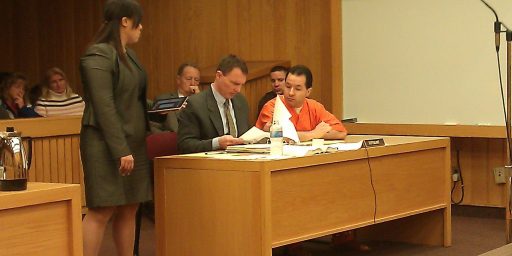Some More Numbers on the Geithner Plan
Were you wondering if yesterday’s big rally was related to the Geithner plan? Well, it probably was.
The Treasury helpfully provides an example, which I reproduce here:
Step 1: If a bank has a pool of residential mortgages with $100 face value that it is seeking to divest, the bank would approach the FDIC.
Step 2: The FDIC would determine, according to the above process, that they would be willing to leverage the pool at a 6-to-1 debt-to-equity ratio.
Step 3: The pool would then be auctioned by the FDIC, with several private sector bidders submitting bids. The highest bid from the private sector — in this example, $84 — would be the winner and would form a Public-Private Investment Fund to purchase the pool of mortgages.
Step 4: Of this $84 purchase price, the FDIC would provide guarantees for $72 of financing, leaving $12 of equity.
Step 5: The Treasury would then provide 50% of the equity funding required on a side-by-side basis with the investor. In this example, Treasury would invest approximately $6, with the private investor contributing $6.
Step 6: The private investor would then manage the servicing of the asset pool and the timing of its disposition on an ongoing basis — using asset managers approved and subject to oversight by the FDIC.
Let’s flesh this out by repeating it 100 times. So say a bank has 100 of these $100 loan pools. And just by way of example, suppose half of them are actually worth $100 and half of them are actually worth zero, and nobody knows which are which. (These numbers are made up but the principle is sound. Nobody knows what the assets are really worth because it depends on future events, like who actually defaults on their mortgages.)
Thus, on average the pools are worth $50 each and the true value of all 100 pools is $5000.
The FDIC provides 6:1 leverage to purchase each pool, and some investor (e.g., a private equity firm) takes them up on it, bidding $84 apiece. Between the FDIC leverage and the Treasury matching funds, the private equity firm thus offers $8400 for all 100 pools but only puts in $600 of its own money.
Half of the pools wind up worthless, so the investor loses $300 total on those. But the other half wind up worth $100 each for a $16 profit. $16 times 50 pools equals $800 total profit which is split 1:1 with the Treasury. So the investor gains $400 on these winning pools. A $400 gain plus a $300 loss equals a $100 net gain, so the investor risked $600 to make $100, a tidy 16.7% return.
The bank unloaded assets worth $5000 for $8400. So the private investor gained $100, the Treasury gained $100, and the bank gained $3400. Somebody must therefore have lost $3600…
…and that would be the FDIC, who was so foolish as to offer 6:1 leverage to purchase assets with a 50% chance of being worthless. But no worries. As long as the FDIC has more expertise in evaluating the risk of toxic assets than the entire private equity and banking worlds combined, there is no way they could be taken to the cleaners like this. What could possibly go wrong?
A couple of points. First, this is just an example to help understand how the plan would work. Hence the numbers and any percentages derived from them are likely to be completely bogus. What is important to take away from this is the qualitative aspect of the post. That is, there is still significant potential for a downside for the FDIC and ultimately for the taxpayer (yes, the FDIC is funded by the banking industry, but if they get into big trouble I have little doubt that the taxpayer will be put on the hook).
This is probably as good a reason (or one of the reasons) for the rally yesterday. As the guys on Wall Street ran this by their number crunchers it became apparent that this plan could offer a very nice deal for distressed financial institutions.
The author of that post, Nemo, has more here as well.
In Part 1, I gave an example of how a private investor could buy some loans for $8400, ultimately realize $5000 on them, and still earn a 16.7% profit. Milo Minderbinder would be proud. The loser would be the FDIC, which is interesting because the FDIC is financed not by the taxpayer but by the banking industry — or at least, it has been so far. So even if the FDIC needs to tap their new $500 billion credit line to make good on tons of bad loans, in theory they will eventually repay the Treasury by exacting higher insurance premia from the banking industry.
Thus Part 1 could be read as a transfer of wealth from good banks to bad banks and private equity. Assuming Treasury actually demands repayment on the credit line and does not just write it off…
Well, great. A transfer of equity from good banks to bad banks. Gee, if you were a good bank what would you be thinking at this point? Time to get the f*ck out of Dodge? How to quickly become a bad bank?
Apparently, we are left with private equity firms and bankers being able to fleece the FDIC and the Fed via abusing the non-recourse loans, with the Treasury/taxpayer participating in the upside of the fleecing. Which is fine, I guess, if you believe the FDIC and Fed are themselves good for the losses; i.e., that the losses will not ultimately be placed on the taxpayer. Color me skeptical, especially with regard to the Fed.
Me too.






The variable of actual worth is likely much higher in the equation. Even if the loan goes bad the house that backs it is still around. There are only a few places in the country where the loans are substantially higher than the home values.
I am not following the accounting in your example. The way I see it, the bank had $10,000 in assets on their books. They sell them for $8400, taking a loss of $1600.
The other point I don’t follow is your assessment that the FDIC will be left picking up the cost of the 50% of worthless assets. My understanding is that the government, via the FED and FDIC, is providing a loan, not guaranteeing against a loss. The only way I see the government getting stuck is if the private equity partner defaulted on their loans.
In the example, the default rate is 50% so actually the value is $5,000.
Its called a non-recourse loan. That is if the investment pays off I pay back the FED/FDIC. If it goes bust, I don’t pay them back.
Since it is a non-recourse loan there is no downside to defaulting. In fact, it isn’t really even defaulting.
No good deeds will go unpunished. That’s the only lesson I can come up with here.
But I would have a question even if I was one of the insolvent banks. At what point does Congress and The One decide that any profits earned become obscene and need to be taxed at a 90% rate, since, you know, it was the people’s money that made it possible?
Does any of this remind anyone else of The Producers?